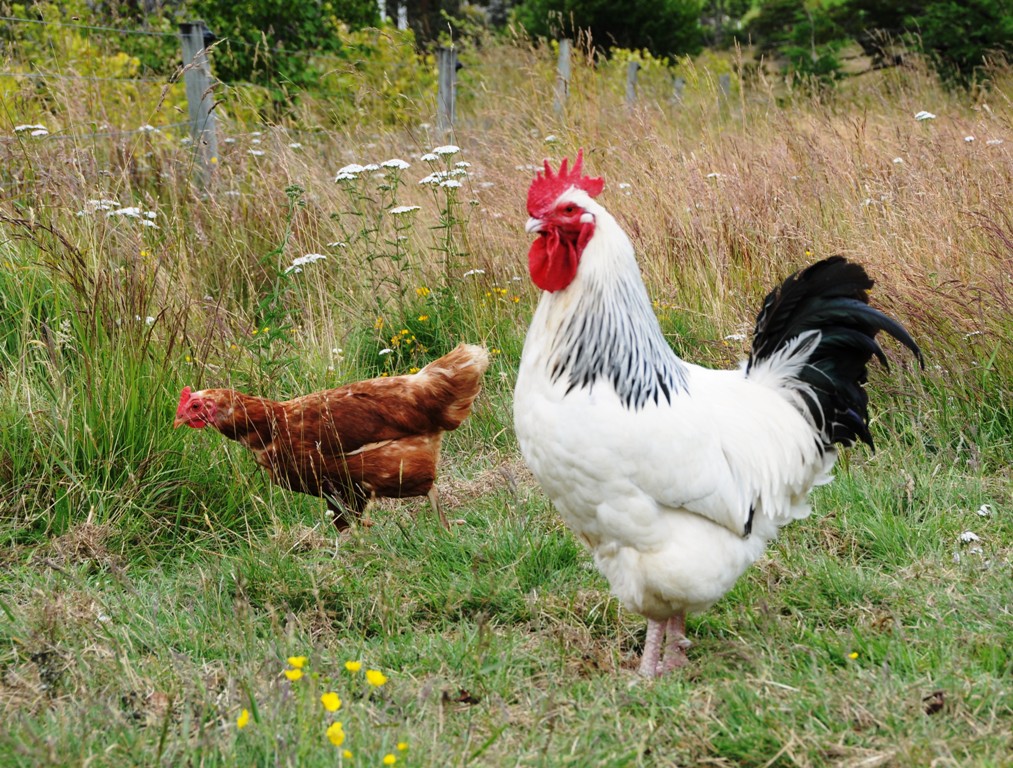chronicles
|
We have a bully: a chook bully that goes around ripping feathers from the breasts of some of her sisters. We know this to be the case because Farmer Wan recently caught her in the act. Unfortunately, he was doing something else at the time and wasn't able to stop her. Now he can't identify her. I have my suspicions but can't be sure unless I catch her at it again. This behaviour, known as "feather pecking" is dangerous for the victims. Chooks will peck at anything coloured red, including tiny blood spots advertising the vacant real estate where feathers once lived. The more the wound bleeds, the more they'll peck at it. Chooks are cannabalistic by nature. 'Nuff said. Feather pecking, according to that repository of all knowledge, Wikipedia, is a behavioural disorder common in birds reared for egg production, especially if they free-range (caged birds either don't have the room or have their beaks trimmed). The behaviour is transferable -- once one bird starts doing it, others will follow -- so naturally we want to nip it in the bud, especially as we've recently bought two 10-week-old pullets that we'll add to the flock once they start laying. The best way to protect the three birds who are worst affected would be to remove them from the flock until their feathers have re-grown. We can't do this because there's nowhere else to put them -- we've already got the two pullets housed separately and two broody chooks sitting on eggs in two other houses. Chook tattooing, anyone? The next best solution is to disguise the bare skin by staining it darker. Most of our chooks are Brown Shavers, so their pink skin contrasts strongly with their brown plumage. We tried an iodine-based spray, which just stained the skin a darker shade of pink. Then we read on an American website about stuff called Blu-Kote. It's germicidal, fungicidal and the active ingredient is gentian violet (anyone of my vintage might remember having it painted on their skin for childhood chicken pox lesions -- it bloody hurt). Gentian violet definitely stains anything it comes into contact with, so we thought we might give it a try. The product isn't available in NZ. Our vet had something similar but it was prescription-only medication and would involve driving a balding chook nearly 100km in to the surgery for a consultation, and then paying a lot of money. Anyone who takes a chook to the vet becomes a laughing stock around here (we know because we did it once, back in the very early days), so we decided it would be easier and cheaper to order the stuff online. When it arrived, Farmer Wan read out the warnings, including this one: Not for use on horses intended for food. I'm loath to turn our baldy chooks toxic and the jury seems to be out on how this stuff affects eggs, so I've decided to try a food colouring-based alternative first and see how effective it is. The Blu-Kote is there only as a last resort. Minimising risk factors We're also trying to control some of the factors that seem to make chooks more prone to feather pecking by: 1. Ensuring the hen houses are clean and air quality inside them is good 2. Adding extra protein (blood and bone) to their food 3. They already have plenty of room to roam around in, so there's not much more we can do about that 4. Giving them a big, beautiful toy to play with, namely: We were told his name was Lucky (possibly because he avoided the Christmas roasting dish by being bought by us) but I promptly changed it to Rocky, purely so that I can greet him like this: He hasn't stopped the feather pecking but the hens adore him and I've noticed the three worst affected girls snuggle up next to him at night, so maybe he's doing some good. I've also noticed that a couple of other chooks are sporting brand new bald patches as a result of Rocky's amorous attentions. Have you ever seen a rooster mount a hen? It's brutal but at least we'll have plenty of fertile eggs to shove under the broodies.
Young Rocky, having now settled in quite nicely, crows lustily whenever he feels like it. This then sets off our little bantam rooster. They yodel back and forth at each other until the bantam starts sneezing. This can be hilarious or a total pain, depending on whether it's three in the afternoon or five in the morning. So now our poultry numbers total eighteen: 11 Brown Shaver hens, two Brown Shaver pullets, a Pekin bantam hen and rooster, Rocky the Light Sussex rooster and two very special girls I call the Oooh La Las (they're a story for another day). Our enslavement is complete. I'll let you know how the blue girls go. Posted by Farmer Nik
4 Comments
I've never been much of a fan of your average domestic fowl. When I was four years old, I was pecked hard on the finger by a neighbour's white Leghorn and that probably has a lot to do with it. Until fairly recently, I considered chooks stupid, vicious and uninspiring. But then we got hens of our own and everything changed. I've watched them run amok at Muntanui since the beginning of the year and can now say in all honesty that I love our girls. They're diligent, dependable and very, very droll. I could sit with them for hours. Their behaviour is fascinating and their vocal range, remarkable. Sometimes they dust-bathe under the house and the noise they make falls somewhere between a trill and a purr. It's a lovely thing, the sound of a contented chook. All through winter, our five Brown Shaver girls each laid one beautiful, brown egg a day. They barely moulted and even when one or two did start looking a little tatty, their laying capabilities never faltered. So when production suddenly dropped over a couple of weeks to four, then three, then two eggs a day, I grew worried. Were they finally going through a serious moult? If so, why so late? If not, were they sick? Were they just... finished? The answer lay in our dwindling hay supply -- or rather, behind it. I was getting ready to feed out the cows, grabbed a bale at the back of the stack and found... this: THIRTEEN of them, the treacherous little devils.
We're not sure why some of the girls abandoned their nesting boxes. We keep a couple of fake wooden eggs in there, which is supposed to stop hens laying elsewhere -- obviously unsuccessful. We began keeping the chooks locked in their yard until mid-morning so they had nowhere else to go. When we got a bit slack and let them out earlier, one started laying in the paddock. We never did find the eggs. Beautiful, brown eggs are still disappearing from Muntanui, even now, but for a totally different reason: I finally plucked up the nerve last week to start selling them. Demand has been so high that we've had to boost the flock with a couple of new chooks. We collected them from the supplier this morning. One of them couldn't wait to get to work; she laid an egg in the box on the way home. And that's our girls for you: diligent. Dedicated. Droll. Posted by Farmer Nik |
About Ewan and NikiFarmer WanScottish mechanical engineer with a deep and abiding passion for good food. Outstanding cook. Builder of lots of stuff. Cattle whisperer. Connoisseur of beer. A lover rather than a fighter. Farmer NikKiwi writer and broadcaster who hates cabbage, even though she knows it's good for her. Chook wrangler. Grower of food and flowers. Maker of fine preserves. Lover of dancing and wine. Definitely a fighter. Archives
November 2016
Categories
All
|




 RSS Feed
RSS Feed
